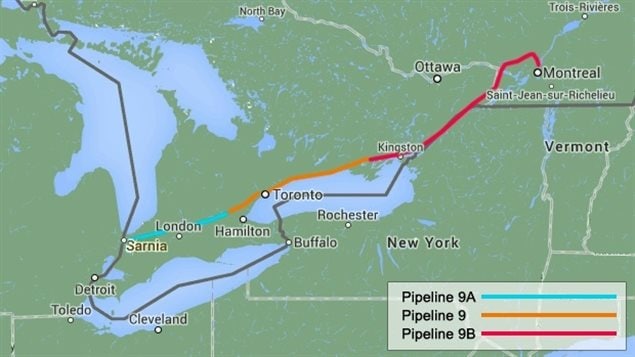Line 9 is the pipeline that runs from Sarnia, Ontario up through the Greater Toronto Area and on to the Montreal region. It is undergoing a second reversal, or ‘re-reversal’.
According to the Enbridge company website, it “has been operating the Line 9 pipeline – an existing 762-mm (30-inch) diameter pipeline, with a current capacity of approximately 240,000 barrels per day – safely and reliably since 1976.”
The website goes on to provide the context for the current situation describing the line as originally having flowed eastward, until this was reversed in 1998 as foreign oil from regions such as the Middle East and West Africa became more affordable. When Western Canadian crude was more affordable than foreign oil, “Enbridge successfully applied to the NEB in November 2012, to reverse the flow of Line 9 once again.”
But now oil prices have changed again and so has the economic landscape. But the “Line 9 reversal and capacity expansion” continues across southern Ontario.
Jessica Lyons is an organizer with No Line 9 in Toronto. The advocacy group has organized a ‘Die-In’ for Monday morning, at 8 am, June 29th, 2015. It is to take place at a busy intersection in the north-central part of city, exactly where the pipe goes through. The theatrical strategy is to garner attention and inform residents about the issues surrounding the reversal.
ListenJessica Lyons says the effect of oil leaks and spills have been witnessed most recently in English Bay in Vancouver, and the Kalamazoo disaster in the United States has not yet been adequately cleaned up, because bitumen is a more challenging substance to collect, as it sinks to the bottom of the river.
Lyons says the bitumen travelling through the pipe is more corrosive than the previous substance and renders the pipe more prone to spills and leaks. Her group is concerned about age of the pipeline, as it was made in the same place and at the same time as the Kalamazoo pipeline which leaked in 2010.
There is also concern about the First Nation’s communities that have not been consulted. The Chippewa of the Thames First Nations have a case in court, but just this week the National Energy Board (NEB) issued its final approval. Lyons says the route through some of the best land in Ontario as well as one of the most populated areas of the country should be raising alarms on many levels.
We’ll follow up on the protest and an interview with Enbridge next week.







For reasons beyond our control, and for an undetermined period of time, our comment section is now closed. However, our social networks remain open to your contributions.